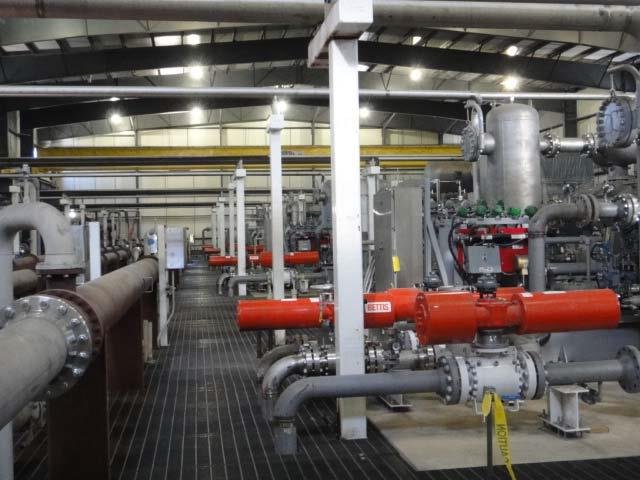The Environmental Protection Agency (EPA) found multiple Safe Drinking Water Act violations at the nation’s first carbon capture and sequestration (CCS) storage project, PoliticoPro’s E&E News reported today.
The Decatur, IL, project, run by Archer-Daniels-Midland (ADM), violated rules meant to protect against leaks of captured carbon, the EPA wrote in a notice of violation issued on August 14th.
The EPA said it had inspected three ADM wells in mid-June — one used for storing captured carbon dioxide and two used to monitor for leaks and other problems.
Subscribe to our newsletter
Stay up to date with DeSmog news and alerts
ADM told E&E News that the violations relate to corrosion in one of the two monitoring wells — a problem that ADM said it had discovered back in March.
ADM was the first company to get a Class VI injection well permit from the U.S.’s EPA. The company started injecting carbon in Illinois at the end of April 2017, making the site a little over seven years old.
Because of the risks captured carbon poses, including risks to the nation’s groundwater supplies, federal rules generally require Class VI wells to be monitored the entire time they’re in use, plus 50 years after — so the discovery of issues at ADM’s project this early on could be a sign of significant problems to come as carbon capture and monitoring wells age.
“This incident puts an exclamation point on concerns communities across the country have been raising for years about the dangers the CCS industry poses to public safety and drinking water,” Food & Water Watch policy director Jim Walsh said in a statement today responding to the news.
“Waiting at least a month to notify the public of this violation is especially egregious given the major health and safety risks associated with carbon dioxide contamination in air and water,” Walsh added. “The lack of transparency from EPA about this leak is alarming but unfortunately in line with a failure of federal oversight for the entire carbon capture industry.”
An ADM spokesperson said drinking water supplies in the Decatur area were not impacted and the monitoring well in question was plugged.
“We detected some corrosion in a section of one of two deep monitoring wells at approximately 5,000 feet and below,” ADM spokesperson Jackie Anderson said in a statement provided to DeSmog.
EPA officials also said that, at the moment, drinking water around Decatur remains unaffected.
“At present, EPA doesn’t have any information to suggest there is a threat to drinking water in nearby communities,” Macy Pressley, a press officer for EPA Region 5, told DeSmog in an email.
“It isn’t the Region’s usual practice to publicize notices of alleged violations,” Pressley added. “In this instance, the Region notified federal elected officials and state and local agencies.”
In August, the EPA pushed ADM to move quickly, giving the company less than a week to start working with regulators to get the project back into compliance with federal law. “Given the public health importance of this matter, please plan to promptly request and thoroughly explain any request for extensions to the timeframes above,” the EPA wrote.
An ‘Active Enforcement Matter’
But it appears that, over a month since the violation was issued, the EPA’s concerns remain unresolved.
“EPA is working with ADM to gather more information and to ensure that issues identified in the notice are addressed as quickly as possible,” Pressley told DeSmog on September 13, adding that because the situation remained an “active enforcement matter,” the agency could not provide further information.
The Decatur project was “the world’s first successful completion of a pure storage carbon capture and storage (CCS) project,” according to ADM. The project captures carbon created as ADM turns corn into ethanol, which can then be blended into gasoline. Studies have found that ethanol-based fuels are worse for the climate than electric vehicles, DeSmog previously reported — and that’s assuming the ethanol plants all successfully use carbon capture.
ADM’s carbon capture project came with a heavy price tag for taxpayers, an Investigate Midwest report found in 2020 — heavier than ADM itself paid. The total tab came to $414.4 million — and taxpayers picked up $281.3 million through Department of Energy grants, federal spending records show, leaving just $133.1 million for the company’s share.
Just two years back, ADM was touting its Decatur project as a major success. “We have now demonstrated CO2 can be safely injected a mile and a half under the earth, setting a new milestone for the world’s understanding and ability to implement industrial CCS systems,” ADM executive Chris Cuddy said in 2022.
Environmental groups have been highly critical of carbon capture schemes, warning that they distract from the ongoing energy transition away from fossil fuels and more viable solutions to the climate crisis, like building out renewable energy infrastructure. “Despite 50 years of development and an estimated USD 83 billion in investments since the 1990s, carbon capture has failed to make a dent in carbon emissions,” an Oil Change International report this summer found. “Carbon capture projects consistently fail, overspend, or underperform.”
The physical risks associated with carbon capture projects are substantial. “Carbon dioxide stored underground has the potential to leak and contaminate groundwater,” DeSmog has previously reported. “It can also induce seismic activity due to pressure built up from the large volume of CO2 injected underground. Stored CO2 could also impact the climate through slow or large releases of CO2 to the surface, further affecting soil, trees, and other vegetation.
One of the major concerns associated with CCS is corrosion — a particular concern given that carbon dioxide can become acidic when mixed with water. That not only leads to ocean acidification, it also makes handling captured carbon potentially risky — as demonstrated by the fire last year at Piñon Midstream’s Dark Horse carbon capture project. Piñon Midstream advertises its Dark Horse project as “engineered and designed to the highest N.A.C.E. [National Association of Corrosion Engineers] specifications.” But DeSmog found the company told New Mexico regulators that imperfections in its pipe system could not have been discovered before the blast.
Those environmental problems are compounded when captured carbon is used to produce more oil. “Of the 32 commercial CCS facilities operating worldwide, 22 use most, or all, of their captured CO2 to push more oil out of already tapped reservoirs,” DeSmog reported last year.
Though it’s touted by the fossil fuel industry as climate-friendly, many oil companies are counting on carbon capture to revive aging oil fields — at the expense of the climate. “A major Canadian oil field in the province of Saskatchewan would likely have reached the end of its life eight years ago,” DeSmog reported this summer. “But thanks to carbon capture and storage, a technology widely touted by the oil and gas industry and some political leaders as a key solution for climate change, the field could still be producing 1.5 million barrels of oil annually by the year 2100.”
Subscribe to our newsletter
Stay up to date with DeSmog news and alerts







